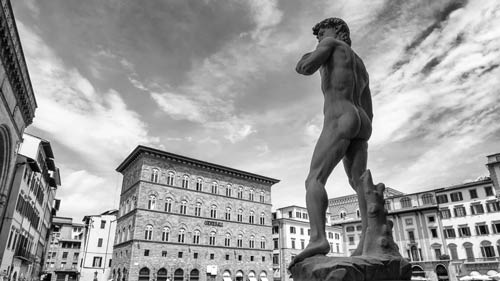Magazine Feature Articles
Matthew Barker: Alone with Michelangelo: Secrets of seeing Florence as the Florentines do
How to make the most of a city that seduces with its sublime art and architecture, while escaping the tourist hordes? Matthew Barker, who lived and worked there, reveals his inside knowledge on the secrets of seeing Florence as the Florentines do.
For all its ravishing beauty, Florence can be maddeningly crammed at times, especially when the tourist season hits full stride in spring and summer. Beating the queues and enjoying some precious quality time alone with Michelangelo or Lorenzo the Magnificent is not always easy. That the centro storico is so compact and easily walkable is one of the city’s greatest plus points; it is also, of course, one of its few downsides. Trying to make your way across the Piazza della Signoria or through the cobbled streets of Sant’ Ambrogio without finding yourself inextricably caught up in a slow-moving coach party from Wisconsin or Stuttgart can be a major challenge.
One obvious solution is simply to make sure you are up and about before everybody else. You can breeze your way through the Uffizi or skip up those 400 steps to the top of the Duomo at a decent time in the morning (nothing too drastic either; before 10am should do it), before our tour package friends have formed an orderly line on the steps outside their hotel. Equally, a late-night visit can be equally hassle- and crowd-free, with plenty of locals in on the secret too, adding to the feeling that you have stumbled into a private party (the Palazzo Strozzi, for example, stays open until 11pm on Thursday nights).
Opening and closing times can often be seasonally adjusted, so check on the web or with the concierge at your hotel first, but a general rule of thumb is that the city’s churches, including the cathedral, are open from 10am to about 5pm (and often a little later in summer)—though this can often change at weekends and, of course, during religious festivals—and most museums and galleries begin their working day at 9am. Both the Uffizi and the Academia Gallery open for business bright and early at 8.15am.
You might want to treat yourself to a lie-in (this is, after all, a holiday). Or you could well have other ideas for the evening. In which case, a little pre-planning may be in order, though you need not worry too much about logistical preparations and poring over maps. The fact is that Italian museums are notoriously lackadaisical when it comes to such newfangled concepts as marketing and customer service. Surrounded by an inexhaustible wealth of art treasures and Renaissance architectural jewels, their relaxed attitude towards publicising their wares is understandable—and means that many smaller museums and churches are left almost untouched, hiding some real delights which you can explore at leisure in your own time and space.
For all that, when it comes to mainstream venues, Florence has been increasingly keen to learn the lessons from Venice, and in recent years has been busily positioning itself as a contemporary, high-tech, fully-wired hub with an international outlook to match. One of the best initiatives which the city offers is the Friends of the Uffizi, which will grant you access to any state-run museum in the city, with one flash of your card whisking you straight to the front of the snaking line of visitors. The scheme covers the Uffizi, Academia, Bargello, San Marco and others. You can join online, or when you arrive in Florence (see amicidegliuffizi.it for details).
Still something of a well-kept secret, and certainly not on any coach party tour itinerary, the Vasari Corridor is the wonderfully regal covered passage that links the Palazzo Vecchio to the Uffizi and across the river all the way up to the Palazzo Pitti. Built by the Grand Duke Cosimo I de’ Medici in the mid-1500s to allow him to walk between the two palaces without being mobbed by the Florentine hoi polloi (clearly crowding was a feature of the city even then), the Corridor is open to small parties on pre-booked visits.
Nearly a kilometre in length, the whole Corridor is lined with more than 1,000 paintings, including self-portraits by such heavyweights as Bernini, Rubens, Ingres, Annibale Carracci and Delacroix. Equally impressive are the views of the city, looking out towards Santo Spirito and up towards the Boboli gardens, or along the Arno from above the goldsmiths’ shops on the Ponte Vecchio. The best way to apply for a tour ticket is by contacting the Uffizi itself (or ask your hotel concierge to arrange it for you).
The city is blessed with hundreds of little gems that never register on the average visitor’s radar. You do not have to stray too far off the beaten track to find yourself far from the madding crowd (simply nipping across the Arno should do it). Picking a quick selection at random, you could pay a visit to the Chiesa di Ognissanti, lined with mediaeval frescoes (including one by Botticelli) and home to the Vespucci Chapel and Domenico Ghirlandaio’s Last Supper. Over in Oltrano sits the Capella dei Brancacci, another surprisingly overlooked jewel and the setting for Masaccio’s masterpiece The Expulsion of Adam and Eve from Paradise.
The San Miniato al Monte church is a sizeable gem, but the hefty climb up the hill tends to put off most casual interest. Time your visit for the early evening (around 6.30pm should do it), when you can enjoy Spinello Aretino’s dazzling frescoes with few distractions, before perching on one of the walls outside and soaking up the views of the city and those rolling Tuscan hills. Squint, and you might just be able to make out those coach parties bumping into each other on the Piazza della Repubblica.
PLEASE READ: CountryClubuk Club Rules and Terms and Conditions

